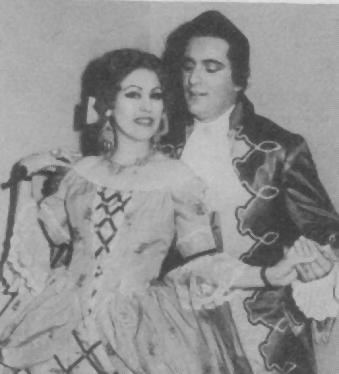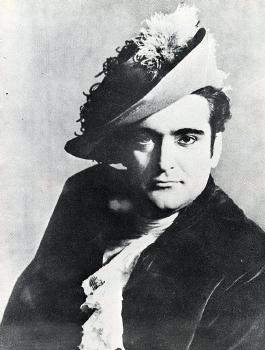It was a local priest who discovered young Carlo Zampighi's voice and encouraged him to take lessons. He studied, in
his native Forlì, first with Giuliana Godoli-Focaccia, then with Anna-Maria Cavalli-Foschi; eventually, he went to
Florence for more profound training at the opera studio of the Teatro Comunale.
It was Magda Olivero who arranged, in 1951, an audition with the famous impresario and agent Carlo Alberto Cappelli for
Zampighi, in the intermission of a performance at the Teatro Duse in Bologna. Cappelli was so impressed that he had a
piano carried onto the stage after the end of the opera, and so he made embarassed Zampighi sing for the first time in
front of an audience, three arias: "È la solita storia", "Una furtiva lagrima" and "Mi par d'udir ancora". It was
such a success that Cappelli sent him to Lamberto Bergamini in Milano, who
was to study L'amico Fritz with him.
In that role, Zampighi made his debut the same year in Genova at the Teatro Augustus. It was the confirmation for Cappelli
that "his" tenor was well-working also in a theater, and he instantly made an exclusive 15-year-contract with him.
Those 15 years became very intense for Zampighi, but also very successful. He sang at every major Italian theater (with
the sole exception of the Teatro Verdi in Trieste), and at many a provincial theater, as well. Abroad, he appeared in
Cairo, Alexandria, Zürich, Madrid, Bilbao, Sevilla, Oviedo, at the Liceu in Barcelona, the Monnaie in Brussels, the
Staatsoper in Berlin, the Champs-Élysées in Paris, the Stoll Theatre in London; every year from 1956 to
1959, he toured South America: Buenos Aires (Colón), La Plata, Montevideo, São Paulo, Rio de Janeiro; in
the USA, he sang in New York City (open air), Dallas (Barbiere with Maria Callas), New Orleans, Cincinnati and
Detroit.
After the end of the contract with Cappelli, in 1966, Zampighi slowed down considerably. He worked in the management of
the Teatro Comunale in Bologna, but he also continued to sing throughout the 1970s: more often abroad than in Italy, more
often in aria recitals than in stage performances.
Zampighi's repertory was small and carefully chosen; he sang tenor lead roles in: Il maestro di musica and Lo
frate 'nnammurato (both by Pergolesi), Il barbiere di Siviglia, La donna del lago (Uberto), La
sonnambula, L'elisir d'amore, Lucia di Lammermoor (Edgardo), Don Pasquale, Les pêcheurs
de perles, Rigoletto, La traviata, Falstaff (Fenton), L'amico Fritz, Pagliacci
(Beppe), Manon, Werther, Gianni Schicchi, Madama Butterfly, La guerra (by Rossellini),
The turn of the screw and Giuliano de' Medici (by Rodolfo Del Corona).
Reference: Fernando Battaglia, L'arte del canto in Romagna, Bologna 1979

